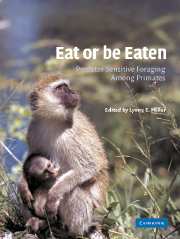Book contents
- Frontmatter
- Contents
- List of contributors
- Preface
- 1 An introduction to predator sensitive foraging
- PART I BIOLOGICAL VARIABLES
- PART II SOCIAL VARIABLES
- PART III ENVIRONMENTAL VARIABLES
- 12 Foraging female baboons exhibit similar patterns of antipredator vigilance across two populations
- 13 Foraging and safety in adult female blue monkeys in the Kakamega Forest, Kenya
- 14 Predicting predation risk for foraging, arboreal monkeys
- 15 Predator sensitive foraging in ateline primates
- 16 Antipredatory behavior in gibbons (Hylobates lar, Khao Yai/Thailand)
- Index
16 - Antipredatory behavior in gibbons (Hylobates lar, Khao Yai/Thailand)
Published online by Cambridge University Press: 10 November 2009
- Frontmatter
- Contents
- List of contributors
- Preface
- 1 An introduction to predator sensitive foraging
- PART I BIOLOGICAL VARIABLES
- PART II SOCIAL VARIABLES
- PART III ENVIRONMENTAL VARIABLES
- 12 Foraging female baboons exhibit similar patterns of antipredator vigilance across two populations
- 13 Foraging and safety in adult female blue monkeys in the Kakamega Forest, Kenya
- 14 Predicting predation risk for foraging, arboreal monkeys
- 15 Predator sensitive foraging in ateline primates
- 16 Antipredatory behavior in gibbons (Hylobates lar, Khao Yai/Thailand)
- Index
Summary
Introduction
Gibbons are small diurnal apes inhabiting the rain forests of South Asia (Preuschoft et al. 1984). The social system is predominantly monogamous and groups have typically only two to six members. Recent studies revealed the existence of extra-pair copulations, partner changes and at least occasional polyandrous or polygynous group composition (Brockelman et al. 1998, Palombit 1994a,b, Reichard 2001, Sommer and Reichard 2000).
Primate species that form single-female groups are relatively rare (Kleiman 1977). Selection pressures such as intergroup competition for food (van Schaik 1989, Wrangham 1980) and predation risk (van Schaik 1983, van Schaik and van Hooff 1983) are believed to favor the development of (polygynous or polygynandrous) multi-female groups. Two factors may thus have caused gibbon females to disperse (van Schaik and van Hooff 1983): (a) strong female–female competition for food; (b) a reduced predation risk due to the extremely arboreal lifestyle of gibbons, their capability of high-speed brachiatory locomotion, and the absence of large primate-hunting eagles (such as crowned hawk eagle, Stephanoaetus coronatus; harpy eagle, Harpia harpyja: great Philippine eagle, Pithecophaga jefferyi) in their habitat.
When scanning the literature on the extent of predation risk actually faced by wild gibbons, only scarce evidence emerges: a full grown siamang was found in the stomach of a python (Schneider 1906) and gibbon hair in two out of 237 samples of leopard faeces (Rabinowitz 1989). When wild gibbons were caught in canopy cage traps during a malaria study in Malaysia, pythons invariably surrounded them, obviously trying to prey on the gibbons (van Gulik 1967).
- Type
- Chapter
- Information
- Eat or be EatenPredator Sensitive Foraging Among Primates, pp. 268 - 292Publisher: Cambridge University PressPrint publication year: 2002
- 19
- Cited by



